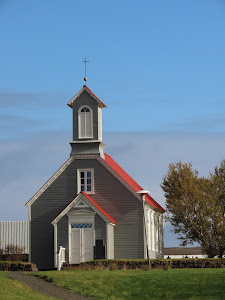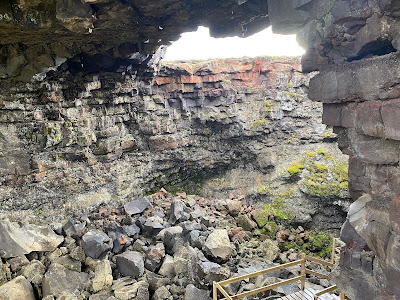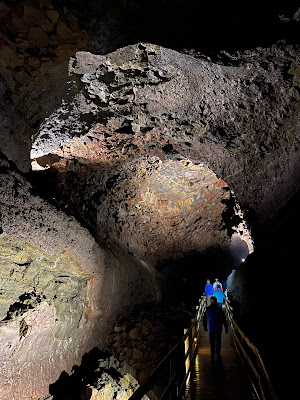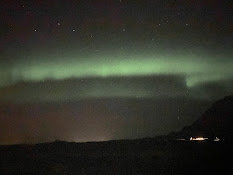West Iceland 2022
Sept 23
Today we are heading West towards Snæfellsnes peninsula. Before we can get going though, we have a few stops along the way, the first stop is at Aðalbakarí, and if you have been following along, you know that is a bakery for breakfast.






Our first real stop was in the town of Hofsós, the Staðarbjörg Basalt Columns line the shore and provide a very nice closeup view of these unique structures. A parking area beside a pool provides easy access to the area.






From the Basalt Columns to our next stop is more of the scenic roadways.


Eventually we arrive in Helluland, the farm home of Iceland Horse Tours. We meet our guide Yula, and got our Icelandic ponies Brúnki and Erpur saddled up for our morning ride.











Yula took us through a wide variety of terrain over a couple hours, marsh, rocky, water, moss, and what seemed like well worn sheep trails... all giving us a better closeup perspective of the Icelandic hillside terrain.









Yula had us attempt to do a special gait that Icelandic horses are famous for. With their little legs they have a high speed trot called a töit. The töit is an extraordinarily smooth four-beat gait, which allows the rider an almost bounce-free ride, even at 32 kmh (20 mph). We did our best, but couldn't convince Brúnki and Erpur to sustain it for any duration.




We finished our ride, and spent a little time talking to the horses before walking slightly bow-legged back to the car.







After spending a couple of hours away from the roads, it was time to go see another waterfall, the Kolugljú waterfalls.








Having met our quota for waterfalls, it was time to head onto Snæfellsnes peninsula, often called Iceland in Miniature. It holds both a volcano and a glacier, lava fields, craters, waterfalls, black and white beaches, caves, picturesque mountains, calm fishing hamlets, villages and towns as well as gorgeous views along the coastline with rugged rocks jutting out from the Atlantic waves.
Stykkishólmur
Our GPS went mad again, sending us down the wrong road to a completely different farm. As we are sitting in some strangers driveway trying to figure out where we are supposed to be, we are waiting for a shotgun-toting farmer to come charging out. He didn't, and we finally figured out where we were supposed to go, down a lovely gravel road with a million speed bumps to arrive at our private in the middle of nowhere Hollywood Cottage. Just 10 Kilometers from the town of Stykkishólmur





The view from the cottage was pretty nice




A long driving day in Iceland, so we stopped at the first place we found in Stykkishólmur for dinner. A hotel with a nice restaurant, a non-tippy table. I knew it was nice, because they had my favourite Icelandic beer. The staff interrupted our dessert to invite us outside and see the Northern Lights. We didn't really see anything aside from crowds staring up at the sky, so we finished dessert, and headed back to our cottage.


In complete darkness at the cottage we could see what looked like long bands of white
clouds, they shifted, changed shape, and appeared in different areas of the sky. They
weren't green, so they couldn't be aurora borealis, right? Wrong, it was our first glimpse
of the Northern Lights. They were just too faint to be able to get a photo, and not strong
enough energy to appear green yet.
May as well go to bed.
Sept 24
In the morning we wake up to sheep outside the window, we're definitely staying in the middle of nowhere.




Today was a nasty day in Iceland, we were getting the tail end of Hurricane Fiona which hit the Canadian Maritimes very hard. Throughout the day we would see winds well over 65 kmh, nearly blowing us off pathways. Then fog, then rain. Then really heavy rain!
Today's adventure would see us do a counter-clockwise loop around the Snæfellsnes peninsula and through Snæfellsjökull National Park. Our first stop was the 4000 year old Beserkjahraun lava field, yep, that's it, didn't take long.


Our plan was to hike up to the majestic Grundarfoss waterfall... it was too windy to stay on the trail, and too wet to take a good picture, we didn't do the hike

The weather turned a bit when we arrived at the majestic Kirkjufell mountain and Kirkjufellsfoss waterfall

Fans of the HBO series Game of Thrones will recognize Kirkjufell as a shooting location from Season 7 of Game of Thrones. The mountain is showcased in the ‘Beyond the Wall’ episode when Jon Snow, The Hound, and Jorah Mormont, among others, brave the wilderness in hopes of catching an undead wight. Having seen it in a vision, The Hound acknowledges Kirkjufell as "the mountain like an arrowhead', and the events that happen beneath it are some of the show’s most dramatic.











Hoping we can see more before the weather gets bad again, we left Kirjufell and continued our loop road around the peninsula.








Olafsvik is an old fishing village with a very modern style triangular shape lutheran church, Olafsvikurkirkja.


The wind is really starting to pick up now.


Waterfalls are starting to blow sideways, and we are having troubles staying on the trails with the wind gusts. Svöðufoss was worth the effort, to the east was a second waterfall called Kerlingarfoss which is fed by a stream so it's much narrower.If there wasn't a risk of being blown over the edge we would have gone to the upper falls lookout.




Ingjaldshólskirkja, built in 1903, is the oldest concrete church in Iceland. Behind the church is a couple statues in tribute to Eggert Ólafsson and his wife, apparently he was famous in the 1700's.



We took a slight detour to Hellissandur so we could see some of their famous street murals.






We had to visit Skarösvik yellow sand beach as it was such a contrast to all the black sand beaches we see everywhere in Iceland. A mix of golden sand, big waves from the storm and volcanic cliffs made this a very dramatic stop. I can imagine it would be beautiful on a nice sunny day.












We stopped at Saxholl crater... it was way too windy to attempt a hike up to the rim.

So, instead, we drove to Hólahar crater, in fact, we drove right inside the crater. Who let's tourists park inside a volcano?





Djúpalónssandur or the Black Lava Pearl Beach is a unique black sand beach. You reach the beach by walking down Nautastígur path (the Path of the Bull). The path will take you through a lava field with huge lava formations.














Too say it was windy while we were standing at this lookout was an understatement, we had to hold on to the handrails to take this pic.

We had planned to go see the Vantshellir cave, but we just missed a tour and the last guided tour was an hour wait. We didn't wait, the weather was turning for the worse, and we didn't want to get stranded in the middle of nowhere.
Instead of going in a cave we went in a cafe... Fjöruhúsið cafe is a family run business, right on the on hillside overlooking the harbour in Hellnar fishing village. Great Coffee and Hot Chocolate, and a delicious traditional Blueberry dessert made this break in our dreary day into a memorable one.




One of our last stops was at the Bárður Snæfellsás statue at Arnastapi. Bárður was the settler of this area, half a troll, and half a man, his father was half a titan, but his mother was human. Bárður came to Iceland in the 9th century and gave the peninsula its name.



Below the statue of Bárður is the basalt column cliff-sides of Arnastapi.




Our last stop was Búdakirkja, the black church. The weather was so bad, we didn't even get out of the car.


It was just torrential as we drove the last leg back to Stykkishólmur. We finally get into town and the first 2 restaurants we try are all reserved for hours (stupid Dineout reservation app won't work if you don't have an active phone #, so we can't make reservations).


They don't have a lot of restaurants in Stykkishólmur, and the ones they do have apparently aren't very big, but at least they have a cool looking church. We ended up at Skurrin and had pizza, Skurrin is also a gas station. Best Gas station pizza we have ever had.


Tummy's full of pizza, we take our leftovers back to our place, so we can stay dry and warm in the confines of our cottage. It was a little bit noisy as we listened to the wind and rain going most of the night.
Sept 25
The weather is much nicer in Iceland today, a little breezy still,but being outside isn't a bad thing. Near the town of Bifrost is Grábrók crater, a volcano and 2 smaller craters that formed 3000 years ago. It's a bit of a hike and a bunch of stairs to get to the rim, but the high wind view is worth the cardio work out.










There is a nice trail that circles the rim of the crater, giving amazing views of the surrounding landscape.



At the base of the crater is the Old Brekka Corral which was built in 1872.Such corrals are used during the autumn sheep round-up. It remained in use until 1922, by which time it was dilapidated.



We had to make a couple quick photo stops along the way; the first for this "picnic
area" right in the middle of a river,
the second for some unique churches in Reykholt.



Our major stop for the day was the beautiful Hraunfossar waterfalls. The name comes from the Icelandic word for lava (hraun) and the word for waterfalls (fossar). Hraunfossar is a series of waterfalls formed by rivulets streaming over a distance of almost a kilometer out of the Hallmundarhraun, a lava field which flowed from an eruption of one of the volcanoes lying under the glacier Langjökull. The waterfalls pour into Hvítá river, from ledges of less porous rock in the lava.


Before we could hike to see them, we had to stop and admire this amazing car at the cafe near the parking lot. A 1959 Olds Super 88. Ok, moving on... The Hraunfossar waterfalls were Norine's favourite of the whole trip.







From the main falls you can walk the hardened lava trails and view the river as well as another less dramatic falls called Barnafoss.




 e
e

Not far from the falls is Víðgelmir, perhaps the best preserved cave of the
well known caves in Iceland. This is due to ice buildup during the 1960s closing off the
only access into Víðgelmir in 1972. It was re-opened in 1994 and closed the
following year with a metal gate to protect the lava formations that have long since have
been destroyed in other well known caves.
The Cave Víðgelmir is located in a lava field called Hallmundarhraun, which is
the largest lava field in Borgarfjörður. Both the exact starting time and
duration of the eruption are not known, but it has been estimated that the eruption lasted
1-4 years and the start of the eruption is usually set at around 900 AD. The cave itself
was formed when the surface lava hardened, while the molten rock beneath it continued to
flow, creating a hollow lava tube.





The entrance is through an area where the roof of the cave collapsed, giving access to the mouth of the cave. You descend a set of stairs to find your self on the floor of the cave either looking up at the sky, or forward into the darkness.








The first part of the cave has one narrow stretch where you have duck and lean to squeeze through the rocks, and then it opens up into a large cavern.It's a little chilly down here, but nobody seems to be noticing the cold.








The wide range of colours and formations is fascinating as you can imagine burning hot magma coursing along these walls.






In the largest of the caverns, our guide gave us a heads up, and then turned out the lights. aside from a tiny bit of light leakage from the previous cave, you could not see your hands in front of your face. Except for a few individuals who have the ability to manufacture shapes using brain memory, yep, that's a thing... it was pitch black. This is as far as we were allowed to travel down the cave, as the rest is reserved for archeologists and scientists to continue to study.









An hour and a half later and we were back above ground, now that was a pretty cool adventure.


We were pretty tired after a day of hiking volcanoes and spelunking a giant lava tube, which can be solved by ending the day in a thermal hot tub. Luckily we were going right past Europe's most powerful hot spring. Deildartunguhver has the highest flow rate of hot springs in Europe. The hot spring pumps 180 liters of 100°C (212°F) water per second, which is partially used to provide geothermal heating to homes in West Iceland.




Adjacent to Deildartunguhver is the Krauma Geothermal Baths & Spa, which offers five hot tubs, one cold tub and two steam baths, as well as a relaxation room where you can unwind to soothing music next to a crackling fireplace. The 100°C (212°F) hot water is mixed with icy cold water from the smallest glacier in Iceland, Ok, and each tub has progressively warmer water ( 35-36°, 37-38°, 38-39°, 40-41°,42-43°and a balmy 5-8° tub to get the blood going).









A great way to wind down, shifting from pool to pool, poolside drink service is included, and they even had a pretty nice restaurant with local Icelandic dishes. Lamb, Cod and a delicious Tomato-Paprika soup wrap up a pretty nice day, especially after the previous day.
Akranes
It's pitch black when we arrive at Móar cottages in the town of Akranes. They are nice and clean on the inside, even if they are a little small and we ended up with bunk beds for our one night stay.


It was a perfect starry night in Iceland, from the front of our cottage we clearly can see the Milky Way, oh, and this just happened... surprised my iPhone could capture a portion of what we just witnessed #auroraborealis #northernlights




























Pretty hard to edit out similar images, but I hope it gives you just a sense of what it was like.
Sept 26
We woke up the next day to beautiful blue skies, and apparently the Móar Cottages are really cute and in a scenic area... too bad we are leaving. Time to pack up and head to our final region of Iceland.




